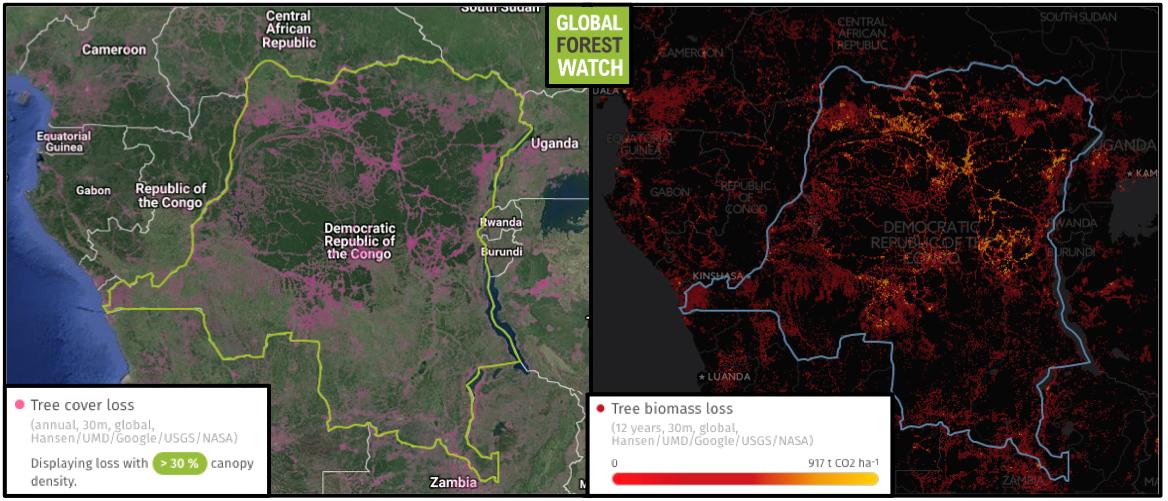- Deforestation rates have been climbing in the DRC, threatening wildlife and releasing huge quantities of CO2 into the atmosphere.
- Research conducted in the country’s northeast found that much of the region’s deforestation was the result of farmers clearing land to earn extra money, not subsistence agriculture as previously believed.
- The researchers say current REDD+ efforts to curb deforestation in the region may be focusing on the wrong driver – and even making the situation worse.
Deforestation rates have been rising in the Democratic Republic of the Congo (DRC) in recent years, threatening the country’s forest-dependent wildlife and releasing millions of tons of CO2 into the atmosphere. Now, a new study may have pinpointed a big reason behind this trend: farmers clearing land to earn money. Its authors say their results upend conventional wisdom and indicate conservation programs like REDD+ tasked with slowing down tropical deforestation may not be giving enough attention to this specific driver.
The study was conducted in a deforestation hotspot in northeastern DRC by researchers from universities in the DRC and Belgium. Published recently in the journal Land Use Policy, it examined an assumption of the DRC government that subsistence farming is driving deforestation in the Central African country. But fieldwork and interviews with 270 Congolese households in 27 villages suggested this is not the case.
“Most of the people surveyed are farmers, and only half of them deforest,” said lead author Pieter Moonen of the University of Leuven in Belgium. “A very small group is behind most of the deforestation. Their motive is not self-sufficiency, but earning money. After all, selling crops on the market is one of the few ways to get cash. They need this money to cover the increasing cost of education and health care or to buy western consumer goods.
“The image of the poor farmer felling trees to feed his family is therefore incorrect. The slightly richer farmers are the ones deforesting to sell their agricultural produce on the market – although ‘rich’ is very relative in this case.”
Moonen added that another important purpose of this kind of deforestation is that it frees up land to become property.
The consequences of deforestation in DRC go beyond the loss of trees. The country’s forest – the world’s largest expanse of rainforest after the Amazon – provides important habitat for a plethora of animals and plants, many of which are found nowhere else. For instance, bonobos (Pan paniscus) are endemic to the DRC, as are okapi (Okapia johnstoni). Both species are listed as Endangered by the IUCN, with habitat loss such as logging considered primary threats to their continued existence.

Deforestation also contributes significantly to atmospheric carbon levels – and, thus, global warming. So much so, in fact, that stemming tropical deforestation is a key element of the Paris Agreement. A legally binding, multinational deal adopted by 195 countries, the Agreement pledges to limit global warming to less than 2 degrees Celsius and is set to take effect in 2020.
The study’s authors write that the DRC has one of the world’s highest levels of land use change-driven CO2 emissions. Data from Global Forest Watch Climate show the country’s loss of 7.9 million hectares of tree cover between 2001 and 2014 – an area bigger than the Czech Republic – released more than 2.9 billion metric tons of CO2. During this period, 2014 had the highest rates of deforestation-caused emissions, topping out at 400 million metric tons of CO2 – about the same as the 2014 emissions of Australia.

Moonen and his team write that their findings may have important implications for regional REDD+ programs. REDD+, which stands for Reducing Emissions from Deforestation and forest Degradation, is an international effort in which wealthier countries provide monetary incentives to developing countries with tropical forests to keep their trees in the ground and thereby slow global warming.
The authors write that the DRC’s current REDD+ policy focuses too much on agricultural intensification as a way to stop deforestation, and is being used as a one-size-fits-all approach across the country when deforestation drivers may vary from region to region. They also admit that their study’s findings represent just one component of a multifaceted, adaptive REDD+ approach they say is needed to affect real change.
“Now that the Paris Agreement on climate change is about to take effect, REDD+ is receiving a lot of attention,” Moonen said. “The Democratic Republic of Congo is interested in taking part: they want to fight deforestation in exchange for financial compensation. But their response to deforestation focuses too much on intensifying agriculture – increasing the amount of produce per hectare. The reasoning is that felling trees is no longer necessary if existing fields yield more produce. This is an effective strategy when dealing with subsistence farming, but it may have a perverse effect when applied to commercial agriculture. After all, it may stimulate the wealthier farmers to deforest more land, so that they have even more produce to sell.
“Therefore, without local support for forest preservation, the outcome of such interventions is very uncertain. In that case, we risk wasting money and valuable time with REDD+.”
Citations:
Hansen, M. C., P. V. Potapov, R. Moore, M. Hancher, S. A. Turubanova, A. Tyukavina, D. Thau, S. V. Stehman, S. J. Goetz, T. R. Loveland, A. Kommareddy, A. Egorov, L. Chini, C. O. Justice, and J. R. G. Townshend. 2013. “High-Resolution Global Maps of 21st-Century Forest Cover Change.” Science 342 (15 November): 850–53. Data available on-line from:http://earthenginepartners.appspot.com/science-2013-global-forest. Accessed through Global Forest Watch on October 26, 2016. www.globalforestwatch.org
Moonen, P. C., Verbist, B., Schaepherders, J., Meyi, M. B., Van Rompaey, A., & Muys, B. (2016). Actor-based identification of deforestation drivers paves the road to effective REDD+ in DR Congo. Land Use Policy, 58, 123-132.
Zarin, D., Harris, N.L. et al. 2015. Can carbon emissions drop by 50% in five years? Global Change Biology, in press.
Banner image: an okapi by Rhett A. Butler
